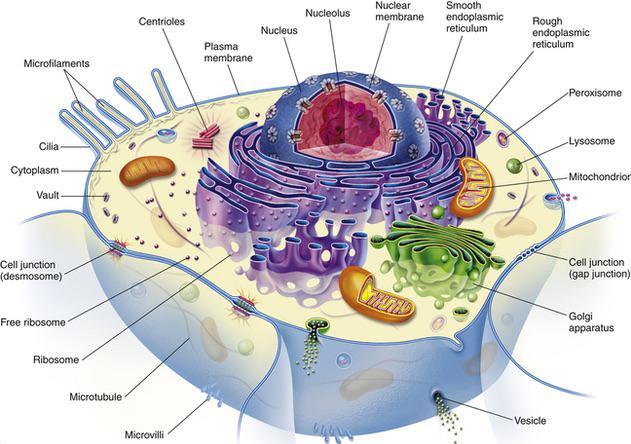Man, it’s so wild how little we know about biology and how much we as a society spend on absolute, utter, bullshit, instead of figuring out how just the basics of us work.
I know it was never possible before modern computers, labs, and equipment, but we really should have like 1000x the amount of basic biological research going on that we do.
I got a degree in microbiology in 95 and I did not know about these. Heck I even did a rotation in an xray crystallography lab which was super into cellular structures.
To be brutally honest, 95 was an eternity ago in microbiology terms. Human genome project didn’t complete till 2003. You must have some wild perspective on seeing us go from what are essentially a modern dark times to modern day
oh certainly. even at that time the xray crystallography lab was basically dying out as it was becoming more of a standard tool rather than an area of research.
From the Age of Enlightenment to essentially space flight, in a single career. 🤓🤌🏼
Oh I think my thing is a bit misleading. I left the field in 1998 and switched to IT for the pay. I pretty much stopped being on the inside at that time.
No worries, I was being hyperbolic anyhow 🤓🤪
my exact feelings, I was like how come I did not know about these
the new update to reality dropped last year. not your fault.
They apparently even patched the text books!

we think about people 100 or 500 years ago and it seems absurd just how little they knew about health and the body, but hopefully we’ll look the same to our descendants in as many years
When I was much younger, the favorite restaurant my family used to treat ourselves to every so often had tables decorated with olde timey newspaper pages. Still very much legible and permanently preserved in epoxy, the advertisements fascinated me — even way back when (≈/< 1930s), the same kinds of “revolutionary” “exotic” “new” tricks that <insert expert title(s)> hate, etc. squawked their bullshit for the punters & mouth breathers. Hell, even Pompeii revealed it’s been going on for millennia… Same as it ever was. 🙇🏽♂️🤓😅
You should check out the dollop podcast. Recently they started doing a segment (the past times) where they read sections from old newspapers (even stuff from the 18th and 19th centuries). Some crazy stuff got printed back in the day and it’s interesting to see how people viewed papers way back in the day.
https://player.fm/series/the-dollop-with-dave-anthony-and-gareth-reynolds-2313603
deleted by creator
It’s astonishing to me just how confidently people, often those who’ve never even studied the body, will assert they definitely know how things work. DNA is the big one for me, as there’s an entire “layer” of genetic function which we know almost nothing about. We may have mapped the atomic structure of DNA, and identified a number of sequences of base pairs which can be correlated with certain traits, yet how DNA “folds” and why remains almost a complete mystery. Many think that scientists have reached a level where we can splice our genetic code as though it were a computer program to make it do this or that, yet in reality attempts to do so almost never work, usually resulting in sterility or death.
Not entirely true. Humans have successfully modified the genome of plants and especially bacteria in a targeted way for years now. But things are of course much more complex in humans and vertebrates in general.
The mystery remains but we certainly can splice our genetic code without sterility or death. There are various FDA approved therapies doing just so to treat genetic diseases such as sickle cell, hemophilia, certain types of DMD, and retinopathies.
Oh it’s certainly possible to do. Just that it’s incredibly dangerous, which is why there is an extremely rigorous testing regime in place, taking many, many years, which must be completed before any particular therapy is approved. Many proposed therapies are never able to successfully complete testing because the most common side effects by far are sterility and death.
The absolute, utterly bullshit is what leads to other advances and a better understanding of the basics. For example, optical storage technology is a direct result of a federally funded study on how moth eyes gather and utilize light.
👀🤩
Yeah, I’m not talking about developing new computer technologies as utter bullshit, I’m talking about the trillions spent on advertising for instance, or social media platforms.
Ask any expert in almost any field of science. If they’re good at their jobs, they’ll mostly tell you the same thing about their field.
The scariest thing in the world is that you can apply that to nearly everything.
Meanwhile in weapons research
“Why can’t I hold all this grant money, lol?”
Is taking people apart not biology?
I think that’s physics
Depends how fast you do it.
This isn’t really true. It’s kind of true for scientists because by their nature, they work on discovering new things, but even still, the amount we know and understand about say, physics and chemistry, is way way way greater than biology.
Like for physics and chemistry we have a very rock solid understanding of how the vast majority of reactions and interactions that effect the universe at our scale, work. Most of what physicists and chemists are learning these days is at the outer edges of what’s physically possible or studying, there’s very few questions left about common, day to day reactions, those are so well understood that they’re considered engineering and not science anymore.
But that’s not the case for biology. We still don’t understand very basic elementary things about the human body and what parts of it even do, let alone the wider, non human biological world. There is truly more unknowns in biology than the other sciences.
All I know is that Vaults are NOT the powerhouse of the cell.
The infographic appears to be noob-friendly because of its title but then expects you to know what VPARP is and what it’s for
Isn’t it that rapping cartoon dog from the PS1?
VPARPAPPA The Rapper?
“Punch, kick, it’s all in the cellular structure!”
Borderlands devs just came up with episode 5
Borderland/Fallout crossover is episode 6. Vault Hunters get a surprise!
Didn’t the Presequel have a DLC where you went inside Claptrap?
Interesting. Makes me wonder if it might play a role in some physical illnesses we haven’t found a cause for yet, especially immune mediated ones.
This is seriously interesting yet unsettling at the same time that these are not being studied more. For whatever reason I have a feeling that they are going to be way more important someday since all creatures have them.
I mean that’s biology. We can do some pretty cool stuff, but we just don’t understand how so much in the human body works. It’s so fucking complex.
I was instantly reminded of the appendix, where for so long we thought it was just an extraneous evolutionary leftover of an organ, only to find out not all that long ago that it actually acts as a seed vault of sorts for our gut’s microbial biome to repopulate the good bacteria in case something bad happens and wipes them out.
Lead researcher has a youtube channel linked at the bottom of that article, too.
What if they’re only to make the cells bigger so our bodies don’t need to make so many of them to reach a total size as large as we are?
Should be called the chungus then
that wouldn’t be an unfounded hypothesis. surface area to volume ratio is extremely important in cells. by artificially lowering the volume (by taking up a lot of it with a structure) the cell can make better use of its existing surface area
though it looks like the volume of these structures aren’t that large comparatively

The key to surviving global thermonuclear war has been hiding in our cells the whole time?

It’s bullet time! We have to figure out how to activate our bullet time or VATS. 😎
I find it fascinating that researchers have been able to acquire so much structural details about vaults without figuring out their purpose. It’s possible that they’re bits of evolutionary garbage - things that don’t contribute to survival in any discernible way, but also don’t hurt anything, so natural selection doesn’t get rid of them.
Cells make too many of them to not have a purpose. There is a large energy cost to manufacturing 10k-100k per cell. That’s enough for selection to remove them if they were useless.
What’s probably going on is they have an important but uncommon purpose. Like a fire extinguisher. They are in most buildings but a lot of people will never see a situation where one is needed.
Incredible article and read that will send me down the rabbit-hole later when I have some free time!
Thanks for sharing!
My wild speculation:
Viral snares/traps? Semi-permeable membrane + RNA; the virus gets in and binds to the RNA inside, then the viral package is “spent” on fake RNA that can’t replicate. The MVP shell could keep regular cellular machinery away from the trap RNA. There are thousands of these vaults within the cell, as to create a bunch of “pits” that a virus could fall into, thus effectively slowing viral spread, even a little?
edit: from a link in the article:
vault protein somehow helps epithelial cells internalize P. aeruginosa, which in turn speeds the clearance of an infection. Compared to normal mice, for example, MVP-less mice were 3 times as likely to die when their lungs were infected with the bacterium
This was mentioned as a hypothesis that was determined to be fruitless. Was this ever explored further? Different viruses, organ systems, etc.? Since it’s in a lot of different organisms, maybe some common virus that affects many different species is affected by this.
This is very interesting.
What’s next, our cells commit usury?
They’re for storing the molecular correlates of trauma, obviously :3
Nice
( N.B. : Typo : “TIL about vaults, the largest structures intheour cells. No one knows what they’re for.” )Whoops! Thanks!
deleted by creator
They’re not “for” anything. No evolutionary trait is. You’re suggesting intelligent design.
No one is suggesting intelligent design. On this planet we use what is known as “colloquialisms” in a non-professional setting. I hope your world learns them someday.
Fair point but dickishly made
Claiming I was suggesting intelligent design when I obviously wasn’t is a pretty dickish thing to say, so…
Strange thing to be insulted by, and strange response! It’s an interesting case. I’ve begun my documentation here
“It’s strange that you’re insulted by my claim that you’re pushing right-wing Christian lies on people.”
And why would you “document” something that’s already on a public website? I’m not clicking on your link to find out. For all I know, it’s malware.
Where on Earth did you get “right-wing Christian lies” from? This is truly remarkable! You’ve invented an entire dialog that never happened to justify a hateful and cruel behavior. Does your wife know about this?
That’s what intelligent design is. Right-wing Christian lies. I’m not sure why you’re now pretending it isn’t.
You seem so upset by something you think you heard. I feel very sorry for you
So you’re saying intelligent design is true? Are you the right-wing Christian?


















